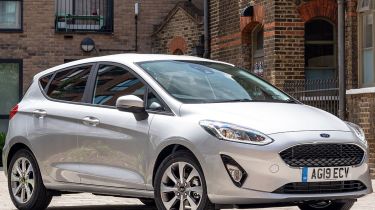Ex-Motability cars: should you buy one?
Some ex-Motability cars can be excellent value, but make sure you do plenty of research before you buy one

Car buyers searching the used market may find an ideal vehicle that was previously part of the Motability scheme. The scheme allows those with qualifying disabilities to use their disability allowances to lease a brand new car that will help keep them mobile. At the end of the lease agreement, the car returns to the Motability charity and is sold to car dealers, usually via auction or a pre-agreed contract. At that point, these ex-Motability cars appear for sale on the open market.
It is easy to find out if a car has just left the Motability scheme as the previous owner on the V5C logbook will be listed as the charity itself since Motability customers only ever lease the vehicle, they don’t own it. The question is, are ex-Motability cars a good buy?
Most car dealers will advise if the car they are selling has come from the Motability scheme, they may even be the dealer that supplied the vehicle to its original recipient. In most cases the car will only have had one owner if it is being supplied directly from the Motability scheme and will be around three years old - the typical length of a Motability lease deal. Initial recipients can extend their lease by up to two years in some cases, so don’t be surprised if you find a vehicle up to five years of age advertised as a one-owner ex-Motability vehicle at a dealer forecourt.
 Free car finance calculator tool: compare used car finance quotes fast
Free car finance calculator tool: compare used car finance quotes fast
As with any other used car, a thorough examination of the car itself and its service history are essential. Under the Motability scheme, servicing costs are included, so all services should have been carried out by a main dealer at the correct mileage or intervals set out in the service book. This means that the car should be well-maintained and in good condition. If they haven’t been carried out, be sure to find out why and be prepared to walk away if you don’t like the answer; there’ll still be plenty of alternatives out there.
Advantages
Due to the nature of the Motability scheme and its customers few vehicles ever rack up their 20,000-mile annual mileage limit and so you’ll usually find an ex-motability vehicle with lower than average mileages.
The cars are also generally kept in good overall condition as lease customers get a bonus if they return the vehicle in above average condition. This incentive and the typically low mileage generally means that the interior and exterior of the vehicle can still look good compared to a non-Motability car of similar age.
Also because servicing is included within the Motability lease agreement, participants have little reason to miss scheduled maintenance and so most vehicles will have a full main dealer service history. Brakes or tyres will also have been replaced without hesitation as these are also covered by the Motability scheme through Kwik Fit auto centres at no charge to lease holders

Finally, some car buyers think that ex-Motability vehicles are different to their privately or business owned counterparts, meaning there can be less interest in the market. For those that know this isn’t the case, it can mean you get a great deal. Some Motability vehicles may have had irreversible conversions carried out, but this is usually limited to a rear lift for wheelchair access and the dealer will advise if this is the case.
Put these factors together and ex-Motability cars can present the opportunity to buy a low mileage, well-kept vehicle that may even be cheaper than similar cars that have been privately owned.
Disadvantages
In some cases, low mileage can be a double-edged sword. It could mean that the vehicle has been unused for long periods of time, or that it’s only been driven regularly for shorter journeys. If a car never gets up to its normal operating temperature, this can potentially damage components or cause them to wear out more quickly than expected.
Depreciation might also be steeper than for a non-Motability car (it might be worth less when you sell it on again), but that’s essentially factored into the lower price you’ll have paid.
Although a bonus for returning a car in good condition, along with free servicing for the duration of lease, means that most ex-Motability cars are usually in good condition there will still be those that treat their vehicles poorly because they don’t own them.
You should also note that just like any other privately owned vehicle there are no rules stopping drivers (without a passenger who is under 18) smoking in the car. Although these are concerns buying any ex-lease car and so look out for tell-tale signs of lingering smoke or poor condition as you normally would.
As should always be the rule when buying a used car, go over everything carefully or, if you don’t feel comfortable doing so, ask someone who knows what they're looking at to inspect the vehicle. Organisations such as the AA and RAC also offer a professional inspection service for a fee. Things to look for include any scratches or repairs to the paint or bodywork, as this can be an indication that the car may not have been cherished. Some Motability cars will feature slight modifications such as handles or specialised seats to suit the previous disabled occupant. Once any adaptations are removed, you could be left with holes or stress points in the interior, so make sure you check the interior panels, dashboard controls and switches are in good working order. Some dealerships may be able to include the cost of fixing any niggles into the price of the car, though this is totally at their discretion.
We’ve heard reports of missing service histories and lots of repairs being needed. However, this can be the case for any type of car on the used market, as condition and service history will be different on every vehicle. It’s not the end of the world if the service book is missing; if you know which main dealership the car was serviced at, they can easily find out when it was serviced by looking at their online records. Many will also be able to send you a replacement service book with the right date stamps in it for future reference.
Should you buy one?
Our advice, like for all used cars, is to carry out as much research as you can into the specific model and example you are looking at. Make sure you take it for a test-drive, see it in the daylight and don’t rush into anything. For extra peace of mind, you may decide to have it inspected by a professional – reputable sellers should allow you to do this, and reluctance to do so may be a sign of an issue.
If you happen to stumble across an ex-Motability car that suits your needs and has been well-looked after, there’s no reason not to choose it over any other vehicle. In fact, you could save yourself quite a lot of money and still get a brilliant car.
Looking to make use of the Motability scheme yourself? Check out our guide to the top 10 best Motability cars
Recommended

Petrol and diesel car ban relaxed with hybrids permitted beyond 2030

Classic car tax exemption: which historic vehicles qualify?

Car warranties: guide to new and used car warranties
Most Popular

Suzuki’s new 10-year warranty is free – here’s how to get it

Omoda E5 targets rivals: now with zero deposit and APR
Tips & advice

Car dashboard warning lights: what does each symbol mean?

Electric car charging stations: public networks, charger types, apps and maps








